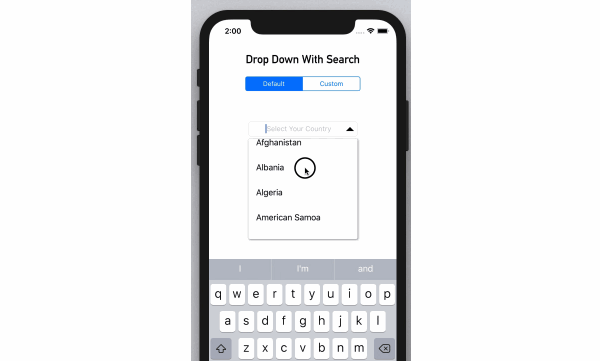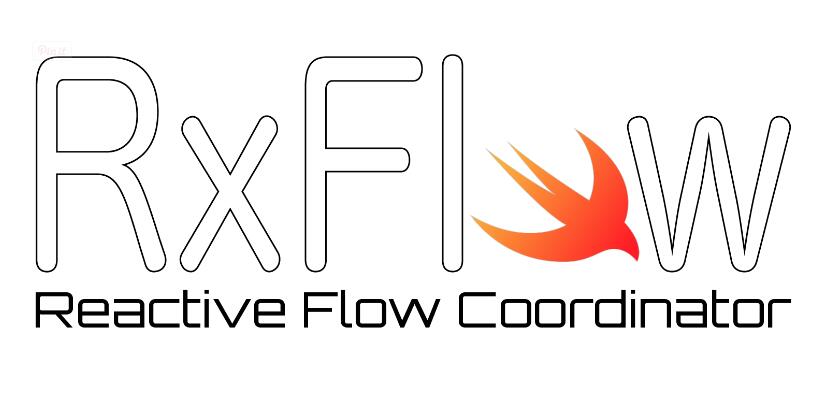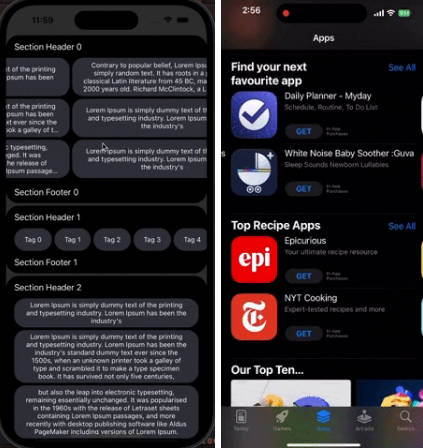WhatsNewKit
WhatsNewKit enables you to easily showcase your awesome new app features.
It's designed from the ground up to be fully customized to your needs.

Features
- [x] Customization and Configuration to your needs ?
- [x] Predefined Themes and Animations ?
- [x] Easily check if your Features have already been presented ?
- [x] Awesome UI ?
Example
The example Application is an excellent way to see WhatsNewKit in action. You get a brief look of the available configuration options and how they affect the look and feel of the WhatsNewViewController. Simply open the WhatsNewKit.xcodeproj and run the WhatsNewKit-Example scheme.
Installation
CocoaPods
WhatsNewKit is available through CocoaPods. To install
it, simply add the following line to your Podfile:
pod 'WhatsNewKit', '~> 1.0.0'
Carthage
Carthage is a decentralized dependency manager that builds your dependencies and provides you with binary frameworks.
To integrate WhatsNewKit into your Xcode project using Carthage, specify it in your Cartfile:
github "SvenTiigi/WhatsNewKit" ~> 1.0.0
Run carthage update --platform iOS to build the framework and drag the built WhatsNewKit.framework into your Xcode project.
On your application targets’ “Build Phases” settings tab, click the “+” icon and choose “New Run Script Phase” and add the Framework path as mentioned in Carthage Getting started Step 4, 5 and 6
Manually
If you prefer not to use any of the aforementioned dependency managers, you can integrate WhatsNewKit into your project manually. Simply drag the Sources Folder into your Xcode project.
Usage
The following first usage description shows the easiest way of presenting your new app features with WhatsNewKit.
?? Please see the Advanced section for further configuration options and features.
WhatsNew
To showcase your awesome new app features, simply setup a WhatsNew struct with a title and items. A WhatsNew.Item represents a single feature that you want to showcase.
// Initialize WhatsNew
let whatsNew = WhatsNew(
// The Title
title: "WhatsNewKit",
// The features you want to showcase
items: [
WhatsNew.Item(
title: "Installation",
subtitle: "You can install WhatsNewKit via CocoaPods or Carthage",
image: .init(named: "installation")
),
WhatsNew.Item(
title: "Open Source",
subtitle: "Contributions are very welcome ??",
image: .init(named: "openSource")
)
]
)
WhatsNewViewController
The presentation of your new app features are handled via the WhatsNewViewController. Simply pass your WhatsNew struct to the initializer and present or push the WhatsNewViewController
// Initialize WhatsNewViewController with WhatsNew
let whatsNewViewController = WhatsNewViewController(
whatsNew: whatsNew
)
// Present it
self.present(whatsNewViewController, animated: true)
Advanced
As mentioned before WhatsNewKit can be fully customized to your needs. The Advanced section will explain all configuration possibilities and features of WhatsNewKit in detail. First off it's important to understand the components of the WhatsNewViewController in order to customize the behaviour and UI-Design.

WhatsNewViewController.Configuration
The WhatsNewViewController.Configuration struct enables you to customize the WhatsNewViewController to your needs.
The WhatsNewViewController.Configuration consist of three main properties.
| Property | Description |
|---|---|
| theme | All UI related settings can be customized here |
| detailButton | Optional detail button to configure the title and the action that should be performed after pressing |
| completionButton | The completion button to configure the title and the corresponding action that should take place after pressing |
The configuration itself can be passed to the initializer of the WhatsNewViewController.
// Initialize default Configuration
let configuration = WhatsNewViewController.Configuration()
// Initialize WhatsNewViewController with custom configuration
let whatsNewViewController = WhatsNewViewController(
whatsNew: whatsNew,
configuration: configuration
)
The upcoming subsection will explain the properties Theme, DetailButton and CompletionButton in detail.
Theme
The WhatsNewViewController.Theme struct allows you to perfectly match the design to your existing App. The following table list the available properties.
| Property | Description |
|---|---|
| backgroundColor | The backgroun color of the WhatsNewViewController |
| titleViewTheme | Customize the font and text color of the TitleView |
| itemsViewTheme | Adjust title and subtitle via text color and font as well as the auto tint image option |
| detailButtonTheme | Title color and font of the DetailButton |
| completionButtonTheme | Configure title color and font for the CompletionButton |
Templates
Beside the full configuration possibilities you can make use of the predefined Theme Templates which are available as static properties. All templates are available in white and dark mode ?.

// Dark Red template Theme
let darkRed = WhatsNewViewController.Theme.darkRed
// White Red template Theme
let whiteRed = WhatsNewViewController.Theme.whiteRed
// TODO: Check out the example application for all available Tempaltes
Animation

By setting the animation property on the WhatsNewViewController.ItemsViewTheme you can apply an animation while displaying the ItemsView.
// Set custom animation for displaying WhatsNew.Item's
theme.itemsViewTheme.animation = .custom(animator: { (view, count) in
// view: The View to perform animation on
// count: The current WhatsNew.Item count (starting at zero)
})
Or you can make use of the predefined animations like fade, slideUp, slideDown, slideLeft, slideRight.
// Set predefined slideUp theme
theme.itemsViewTheme.animation = .slideUp
☝️ In default the Animation is set to
.none
DetailButton

By setting an DetailButton struct on the WhatsNewViewController.Configuration struct you can customize the title and the corresponding action of the displayed detail button on the WhatsNewViewController. As the DetailButton struct is declared as optional the WhatsNewViewController will only display the button if a DetailButton configuration is available
| Action | Description |
|---|---|
| website | When the user pressed the detail button a SFSafariViewController with the given URL will be presented |
| custom | After the detail button has been pressed by the user, your custom action will be invoked |
// Initialize DetailButton with title and open website at url
let detailButton = WhatsNewViewController.DetailButton(
title: "Read more",
action: .website(url: "https://github.com/SvenTiigi/WhatsNewKit")
)
// Initialize DetailButton with title and custom action
let detailButton = WhatsNewViewController.DetailButton(
title: "Read more",
action: .custom(action: { (whatsNewViewController) in {
// Perform custom action on detail button pressed
})
)
CompletionButton

The CompletionButton struct configures the displayed title and the action when the user pressed the completion button on the WhatsNewViewController.
| Action | Description |
|---|---|
| dismiss | When the user pressed the completion button, the WhatsNewViewController will be dismissed. This is the default value |
| custom | After the completion button has been pressed by the user, your custom action will be invoked |
// Initialize CompletionButton with title and dismiss action
let completionButton = WhatsNewViewController.CompletionButton(
title: "Continue",
action: .dismiss
)
// Initialize CompletionButton with title and custom action
let completionButton = WhatsNewViewController.CompletionButton(
title: "Continue",
action: .custom(action: { (whatsNewViewController) in {
// Perform custom action on completion button pressed
})
)
WhatsNewVersionStore

If we speak about presenting awesome new app features we have to take care that this kind of UI action only happens once if the user installed the app or opened it after an update. The WhatsNewKit offers a protocol oriented solution for this kind of problem via the WhatsNewVersionStore protocol.
public typealias WhatsNewVersionStore = WriteableWhatsNewVersionStore & ReadableWhatsNewVersionStore
public protocol WriteableWhatsNewVersionStore {
func set(version: WhatsNew.Version)
}
public protocol ReadableWhatsNewVersionStore {
func has(version: WhatsNew.Version) -> Bool
}
The WhatsNewViewController will use the APIs of the WhatsNewVersionStore in the following way.
| API | Description |
|---|---|
| has(version:) | Checks if the Whatsnew.Version is available and will return nil during initialization. |
| set(version:) | The WhatsNew.Version will be set after the CompletionButton has been pressed. |
The WhatsNewVersionStore can be passed as an parameter to the initializer. If you do so the initializer will become optional.
// Initialize WhatsNewViewController with WhatsNewVersionStore
let whatsNewViewController: WhatsNewViewController? = WhatsNewViewController(
whatsNew: whatsNew,
versionStore: myVersionStore
)
// Check if WhatsNewViewController is available to present it.
// If it's nil the user has already seen your new features for the corresponding Version.
// ...
☝️ Please keep in mind the
WhatsNewViewControllerinitializer will only becomeoptionaland checks if the Version has been already presented if you pass aWhatsNewVersionStoreobject.
Implementation
If you already handled saving user settings in your app to something like Realm, CoreData or UserDefaults you can conform the WhatsNewVersionStore and pass it as an initializer parameter to the WhatsNewViewController.
// Extend your existing App-Logic
extension MyUserSettingsDatabase: WhatsNewVersionStore {
// Implement me ??
}
Predefined Implementations
If not you can make use of the predefined WhatsNewVersionStore implementations which WhatsNewKit offers.
// Local KeyValueStore
let keyValueVersionStore = KeyValueWhatsNewVersionStore(
keyValueable: UserDefaults.standard
)
// iCloud KeyValueStore
let keyValueVersionStore = KeyValueWhatsNewVersionStore(
keyValueable: NSUbiquitousKeyValueStore.default
)
// Initialize WhatsNewViewController with KeyValueWhatsNewVersionStore
let whatsNewViewController: WhatsNewViewController? = WhatsNewViewController(
whatsNew: whatsNew,
versionStore: keyValueVersionStore
)
Saves and retrieves the
WhatsNew.Versionvia aKeyValueableprotocol conform object. UserDefaults and NSUbiquitousKeyValueStore are already conform to that protocol ?
// Initialize WhatsNewViewController with InMemoryWhatsNewVersionStore
let whatsNewViewController: WhatsNewViewController? = WhatsNewViewController(
whatsNew: whatsNew,
versionStore: InMemoryWhatsNewVersionStore()
)
Saves and retrieves the
WhatsNew.Versionin memory. Perfect for development or testing phase ??
WhatsNew.Version
During the initialization of the WhatsNew struct the WhatsNewKit will automatically retrieve the current App-Version via the CFBundleShortVersionString and construct a WhatsNew.Version for you which is used by the WhatsNewVersionStore protocol in order to persist the presented app versions. If you want to manually set the version you can do it like the following example.
// Initialize Version 1.0.0
let version = WhatsNew.Version(
major: 1,
minor: 0,
patch: 0
)
// Use a String literal
let version = WhatsNew.Version(stringLiteral: "1.0.0")
// Current Version in Bundle (Default)
let version = WhatsNew.Version.current()
After you initialize a WhatsNew.Version you can pass it to the initializer of a WhatsNew struct.
// Initialize WhatsNew with Title and Items
let whatsNew = WhatsNew(
version: version,
title: "WhatsNewKit",
items: []
)
Codable WhatsNew
The WhatsNew struct is conform the Codable protocol which allows you to initialize a WhatsNew struct via JSON.
{
"version": {
"major": 1,
"minor": 0,
"patch": 0
},
"title": "WhatsNewKit",
"items": [
{
"title": "Open Source",
"subtitle": "Contributions are very welcome ??",
"image": "data:image/png;base64,R0lG42......."
}
]
}
The optional image property of the WhatsNew.Item will be decoded and encoded in Base64.
// Encode to JSON
let encoded = try? JSONEncoder().encode(whatsNew)
// Decode from JSON data
let decoded = try? JSONDecoder().decode(WhatsNew.self, from: data)





